Galičnik
| Galičnik Галичник | |
|---|---|
| Village | |
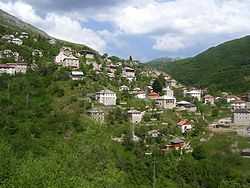 | |
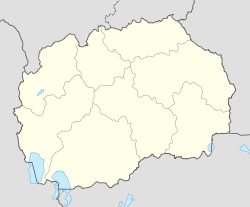 Galičnik | |
| Coordinates: 41°35′39″N 20°39′11″E / 41.59417°N 20.65306°ECoordinates: 41°35′39″N 20°39′11″E / 41.59417°N 20.65306°E | |
| Country |
|
| Region | Polog region |
| Municipality | Mavrovo and Rostuša Municipality |
| Highest elevation | 1,500 m (4,900 ft) |
| Population (2002) | |
| • Total | 3 |
| Time zone | CET (UTC+1) |
| • Summer (DST) | CEST (UTC+2) |
| Car plates | GV |
Galičnik (Macedonian: Галичник) is a mountain village in the Republic of Macedonia and along with Lazaropole is one of the two biggest and oldest Mijak villages in the region. Galičnik has well preserved traditional architecture, including an amphitheater in the village square, and is famous for its surrounding countryside and nature reserve. People from Galičnik and northwestern Macedonia appreciate the local yellow cheese kaškaval(Kashkaval) that is produced in the region as well as the local salt brine white cheese "belo sirenje" which is homemade speciality for this region.
Location
It is located on the slopes of the Bistra Mountain, some 10 km from the artificial Lake Mavrovo and the Zare Lazarevski winter resort.
History
The village is part of the Miyak region and the Macedonian people living here are called Miyaks (Macedonian: Мијаци) (Mijaci) - the name of the Macedonian tribe whose ancestors settled in mountainous villages in the northwestern region of Macedonia. This region has plentiful rich pastures for livestock grazing and this feature attracted numerous nomadic tribes who created settlements based on cattle-breeding and Shepherding.[1]
In the past, the economy of Galičnik relied on livestock, especially sheep trade; producing cheese, meat and wool products. Many families with huge flocks made fortunes and became very rich; these people became known locally as "chobans" a word meaning shepherds.
There was a strong tradition of "Pečalba," or seasonal work, where many of the men would leave the village to work in larger towns and cities as skilled laborers such as masons, carpenters and painters. They would be absent from Galičnik for months or even years at a time. By pečalba they earned enough to support their families. They sometimes became wealthy doing pečalba.
Events
The most important event in the village is the Galička Svadba, a traditional wedding custom held annually in summer (in July), on the day of the village feast of the Patron Saint – Petrovden (St. Peter's day). During the wedding, local men will dance the "Teškoto" (the "hard" or "heavy") - a dance that is meant to symbolize the overcoming of difficulties in life.[2]
Another manifestation that takes place in Galičnik each year is the Galičnik Art Colony.
Notable people from Galičnik
- Aleksandar Sarievski (1922–2002)
- Georgi Pulevski (1838–1895)
- Parteniy Zografski (1818–1876)
- Dimitrije Bužarovski (b. 1952)
- Doksim Mihailović (1883–1912)
-

Galičnik, Skudrinje and Debar lake.
-

Church of St.Peter and Paul.
-
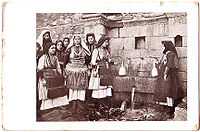
Old postcard from Galičnik - 1903-1908.
-
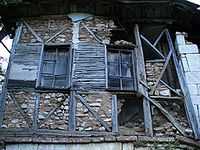
Detail of the architecture in Galičnik.
-
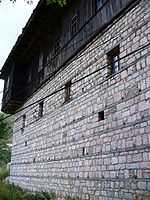
Architecture in Galičnik.
-

2009: Galičnik's wedding poster.
See also
References
- ↑ http://books.google.com/books?id=35oIbNIIn-8C&pg=PA100&dq=mijaci&lr=#PPA100,M1
- ↑ "Teskoto". www.soros.org.mk. Retrieved 2008-10-19.
External links
- Official web site of Galichnik
- Penultimate Phase of Procedure for Entrance of Galicnik Wedding in UNSECO List - Custom with More than 30 Rites
- Galicnik Macedonia,Kinoteka na Makedonija 1939-40 from filmarchivesonline
- Images from Galičnik
- Photos from Galichnik Wedding
| Wikimedia Commons has media related to Galičnik. |